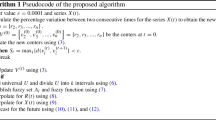Abstract
This paper presents a prediction model based on an improved fuzzy time series (IFTS) and a modified group search optimizer to effectively solve forecasting problems. IFTS can accurately predict whether subsequent predicted data will increase or decrease according to ratio value in the fuzzy logical relationship. In addition, the modified group search optimizer is used to adjust the length of an interval. The proposed prediction model is also used to forecast the enrollments of the University of Alabama the enrollments of a university of technology in central Taiwan, and the Taiwan Stock Exchange Capitalization Weighted Stock Index (TAIEX) Experimental results show that the proposed model obtains the smallest prediction error than those of other methods.






Similar content being viewed by others
References
Vamitha V, Jeyanthi M, Rajaram S, Revathi T (2012) Temperature prediction using fuzzy time series and multivariate Markov chain. International Journal of Fuzzy Mathematics and Systems 2(3):217–230
Wang CH (2004) Predicting tourism demand using fuzzy time-series and hybrid grey theory. Tour Manag 25(3):367– 374
Duru O (2010) A fuzzy integrated logical forecasting model for dry bulk shipping index forecasting: An improved fuzzy time series approach. Expert Systems with Applications 37(7):5372–5380
Song Q, Chissom BS (1993) Forecasting enrollments with fuzzy time series- Part I. Fuzzy Sets Syst 54 (1):1–9
Song Q, Chissom BS (1994) Forecasting enrollments with fuzzy time series- Part II. Fuzzy Sets Syst 62 (1):1–8
Chen SM (1996) Forecasting enrollments based on fuzzy time series. Fuzzy Sets Syst 81(3):311–3191
Yu HK (2005) Weighted fuzzy time series models for TAIEX forecasting. Phys A 349(3-4):609–624
Huarng K (2001) Effective lengths of intervals to improve forecasting in fuzzy time series. Fuzzy Sets Syst 123(3):387– 394
Chen SM, Chung NY (2006) Forecasting enrollments using high-order fuzzy time series and genetic algorithms. Int J Intell Syst 21:485–501
Kuo IH, Horng SJ, Kao TW, Lin TL, Lee CL, Pan Y (2009) An improved method for forecasting enrollments based on fuzzy time series and particle swarm optimization. Expert Systems with Applications 36 (3):6108–6117
Huang YL, Horng SJ, He M, Fan P, Kao TW, Khan MK, Lai JL, Kuo IH (2011) A hybrid forecasting model for enrollments based on aggregated fuzzy time series and particle swarm optimization. Expert Syst Appl 38(7):8014–8023
Huang Y, Horng S, Kao T (2011) An improved forecasting model based on the weighted fuzzy relationship matrix combined with a PSO adaptation for enrollments. International Journal of Innovative Computing, Information and Control 7(7A):4027–4046
Zadeh LA (1965) Fuzzy sets. Inf Control 8:338–353
He S, Wu QH, Saunders JR (2009) Group search optimizer: an optimization algorithm inspired by animal searching behavior. IEEE Trans Evol Comput 13(5):973–990
Shen H, Zhu Y L, Niu B, et al (2009) An improved group search optimizer for mechanical design optimization problems. Prog Nat Sci 19:91–97
Moradi-Dalvand M, Mohammadi-Ivatloo B, Najafi A, Rabiee A (2012) Continuous quick group search optimizer for solving non-convex economic dispatch problems. Electr Power Syst Res 93:93–105
Kang Q, Lan T, Yan Y, Wang L, Wu Q (2012) Group search optimizer based optimal location and capacity of distributed generations. Neurocomputing 78(1):55–63
Nian XY, Wang ZL, Qian F (2013) A hybrid algorithm based on differential evolution and group search optimization and its application on ethylene cracking furnace. Chin J Chem Eng 21(5):537–543
Sullivan J, Woodall WH (1994) A comparison of fuzzy forecasting and Markov modeling. Fuzzy Sets Syst 64(3):279– 293
Huarng K (2001) Heuristic models of fuzzy time series for forecasting. Fuzzy Sets Syst 123(3):369–386
Qiu W, Liu X, Li H (2011) A generalized method for forecasting based on fuzzy time series. Expert Systems with Applications 38:10446–10453
Gangwar SS, Kumar S (2012) Partitions based computational method for high-order fuzzy time series forecasting. Expert Systems with Applications 39:12158–12164
Egrioglu E, Yolcu U, Aladag CH, Kocak C An ARMA type fuzzy time series forecasting method based on particle swarm optimization, Mathematical Problems in Engineering, Vol. 2013 Article ID 935815, doi:10.1155/2013/935815
Wang JW, Chen KH (2013) Frequency-weighted fuzzy time series model based on time variations. Classics in Applied Mathematics (CIAM) 11(2):76–90
Qiu W, Zhang C, Ping Z (2015) Generalized fuzzy time series forecasting model enhanced with particle swarm optimization. International Journal of u- and e- Service, Science and Technology 8(5):129–140
Author information
Authors and Affiliations
Corresponding author
Rights and permissions
About this article
Cite this article
Lee, CL., Kuo, SC. & Lin, CJ. An efficient forecasting model based on an improved fuzzy time series and a modified group search optimizer. Appl Intell 46, 641–651 (2017). https://doi.org/10.1007/s10489-016-0857-0
Published:
Issue Date:
DOI: https://doi.org/10.1007/s10489-016-0857-0




